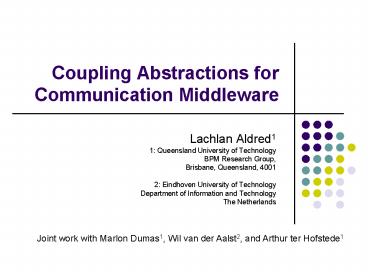Coupling Abstractions for Communication Middleware - PowerPoint PPT Presentation
1 / 20
Title:
Coupling Abstractions for Communication Middleware
Description:
BPM Research Group, Brisbane, Queensland, 4001. 2: Eindhoven University ... Deals with interoperability issues induced by workflow /BPM language heterogeneity. ... – PowerPoint PPT presentation
Number of Views:21
Avg rating:3.0/5.0
Title: Coupling Abstractions for Communication Middleware
1
Coupling Abstractions for Communication Middleware
- Lachlan Aldred1
- 1 Queensland University of Technology
- BPM Research Group,
- Brisbane, Queensland, 4001
- 2 Eindhoven University of Technology
- Department of Information and Technology
- The Netherlands
Joint work with Marlon Dumas1, Wil van der
Aalst2, and Arthur ter Hofstede1
2
Context
- An Australian Research Council funded project.
- Deals with interoperability issues induced by
workflow /BPM language heterogeneity. - Focus is on process integration modelling.
- YAWL - a powerful workflow language
- a best of breed of practical insights (workflow
patterns) and theoretical insights (Petri nets). - Inception 2002.
- Sourceforge implementation gt 1500 d/l month.
- Backed by a fortune 500 company in the US and a
Telco in the UK.
3
The Problem
- Distributed architectures are highly
heterogeneous, including their requirements for
coupling. - Terms such as (a-) synchronous, (non-) blocking,
and (non-) directed are used to describe
coupling. - These are often used with various connotations in
mind. - Informal definitions exist, but no overarching
framework. - Perhaps the right set of abstractions are
missing. - The vendors claim that the problem is solved.
- Their solutions are big sexy and expensive so it
must be true! - Researchers agree seem to agree that the problem
is not solved. - Solutions are for too conceptually diverse.
- Hence models over distributed systems are not
portable, conceptually or otherwise.
4
Objectives
- Find a conceptually complete set of abstractions
for defining the decoupled-ness of applications. - Establish a formal semantics for each abstraction
in terms of CPNs. - Create a notation that represents their semantics
e.g. based on Message Sequence Charts. - The classification of middleware according to
their ability to provide support for each
abstraction.
5
The 3 Dimensions of decoupling
- Taken from the work of Eugster et.al. Eug 2003
- Synchronisation decoupling receives and sends
are non blocking. - Time decoupling - the sender and receiver of a
message do not need to interact at the same
moment. - Space decoupling the sender does not need to
directly address the recipient. - Some of these are not well understood, and have
not been the subject of a formal analysis.
6
Synchronisation decouplingNon-blocking send
- Sender object /application doesnt need to yield
its thread. - Middleware client (inside application) uses its
own thread. - CPN shows that embedded middleware is time,
space, synch coupled regardless. - Fairly uncommon, never seen is RPC paradigms,
rarely seen in MOM. - Store-N-Forward, useful over unreliable
connections.
7
Synchronisation decouplingNon-blocking send
(continued)
- Dotted lines represent application embedded
middleware. - Processing and sending can be interleaved.
- Transition initiate.
- begin can fire at same time as process.
- begin finish exist at boundary of system.
8
Synchronisation decouplingNon-blocking receive
- Doesnt need to yield its thread.
- Object/app either polls middleware client (e.g.
MPI) or client triggers thread creation inside
application (e.g. JMS). - Total synch-decoupling implies NB-send
NB-receive otherwise partial.
9
Synchronisation decouplingNon-blocking receive
(continued)
- Transitions begin finish are shared hence
systems are transition bounded. - After transition initiate has fired CPN is
primed to receive messages. - System never prevents process from firing.
10
Time decoupling
- The receiver can be down when the sender sends (
vice versa). - Relies on half way destination (e.g. message
server, directory file, DB). - Petri net analysis reveals that time (de-)coupled
systems, are (not) transition-bounded.
11
Space decoupling
- The sender need not directly address the
receiver. - Address abstraction is a channel - used by sender
receiver. - Channel abstraction holds for single message and
publish subscribe. - Petri net analysis shows that it does not relate
to time decoupling.
12
The 3 Dimensions of Decoupling
- Underpin most integration models.
- Now have precise semantics.
- Can be combined.
13
Combining the 3Ds
14
Combining the 3Ds (continued)
- Formal semantics of each dimension are clear,
concise. - They do not create any side effects on any other
dimension. - Therefore in one directional messaging there are
(22 x 2 x 2 16) coupling combinations. - Each combination can be formally defined by
overlaying the CPNs of each of the 3 dimensions. - Each one with its own behaviour potential
usages.
15
Combining the 3Ds - CPN
- e.g. Synch Coupled (total), Time Coupled, Space
Coupled
16
Combining the 3Ds - CPN
- e.g. Synch Decoupled (total), Time Decoupled,
Space Decoupled
17
Middleware Comparison Matrix
18
Conclusions
- Time de/coupling ? ? Synchronisation de/coupling.
- ?terms such as a/synchronous are too imprecise
for distributed modelling. - The abstractions alleviate the middleware
muddle. - Support is fractured.
- Little or no overlap. No configuration supported
by all platforms. - Platforms mostly specialize on 1 or 2 coupling
abstractions. - None of the surveyed platforms supported more
than 25 of the 16 abstractions.
19
Further Work
- Seeking to create a language for modelling the
integration of Business Processes. - These abstractions will form a layer between
middleware platforms and the core process
constructs. - They allow us to represent strong integration
models without tight bindings to m/w platforms. - This will allow integration modellers to change
and flex with changing business requirements. - May need to refine notation.
- Would need to do more careful study existing of
middleware platforms.
20
Questions?






























